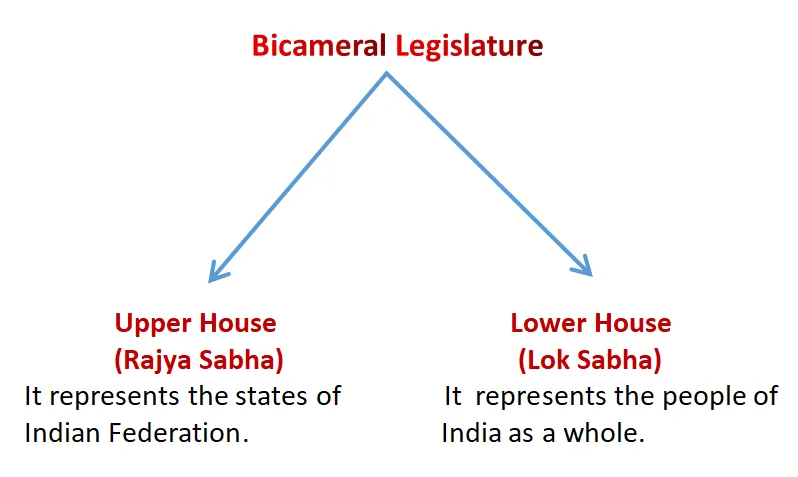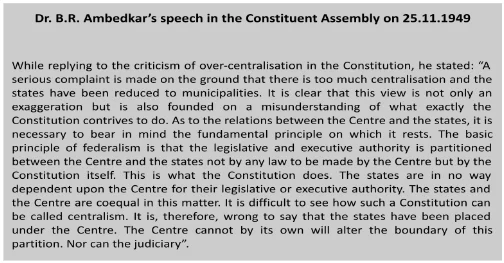The Indian Constitution blends federal and unitary features, creating a unique system that balances power between the central and state governments. It establishes a dual polity, with the Union and state governments handling different areas of governance. While maintaining a federal framework, the Constitution incorporates several unitary aspects to ensure national unity and effective central control.
Federal and Unitary Features of the Indian Constitution #
The federal features of the Indian Constitution are explained below #
- Dual Polity: The Indian Constitution establishes a dual polity which consists of the Union at the Centre and the States.
- The Union government at the centre deals with matters of national importance like defence, foreign affairs, currency, and so on.
- The state governments, on the other hand, deal with matters of regional and local importance like public order, agriculture, health, local government and so on.
- Written Constitution: The Indian Constitution is not only a written document but the lengthiest Constitution in the world.
- At present, it consists of a Preamble, about 470 Articles (divided into XXV Parts) and 12 Schedules.
- It prescribes the jurisdiction within which both the centre and state must perform functions.
- Division of Powers:

- Both the Centre and the states can make laws on the subjects of the concurrent list, but in case of a conflict, the law made by the centre prevails.
- The subjects which are not mentioned in any of the three lists (i.e. Residuary subjects) are given to the Centre.
Enroll now for UPSC Online Course
- Supremacy of the Constitution: The Constitution is the supreme law of the land.
- The laws enacted by the Centre and the states must conform to its provisions.
- The organs of the government such as legislative, executive and judicial at both levels must operate within the jurisdiction prescribed by the Constitution.
- Otherwise, they can be declared invalid through judicial review.
- Rigid Constitution: The Indian Constitution is rigid because the provisions which are concerned with the federal structure require special procedures for its amendment.
- Bicameralism: The Parliament of India is bicameral, consisting of the Rajya Sabha (Council of States) and the Lok Sabha (House of the People).
- The Rajya Sabha represents the states and union territories, while the Lok Sabha represents the people of India as a whole.

- Independent Judiciary: The Indian Constitution contains measures like security of tenure to judges, fixed service conditions etc., to make the judiciary independent of the government.
- It establishes an independent judiciary headed by the Supreme Court for two purposes:
- To protect the supremacy of the Constitution by exercising the power of judicial review, and
- To settle the disputes between the Centre and the States or between the States.
Unitary Features of The Constitution #
Strong Centre: The division of powers is in favour of the Centre as #
- The Union List of the seventh schedule contains more subjects than the State List.
- The Union List contains more important subjects.
- The Centre has overriding authority over the Concurrent List.
- The Centre has given residuary powers.

- Single Constitution: The Indian Constitution embodies not only the Constitution of the Centre but also those of the states.
- No Equality of State Representation: In India, the states are given representation in the Rajya Sabha on the basis of population.
- In the US, on the other hand, the principle of equality of representation of states in the Upper House is fully recognised, meaning equal representation irrespective of population.
- States Not Indestructible: Indian states have no right to territorial integrity.
- The Parliament can alone change the area, boundaries or name of any state.
- Hence, the Indian Federation can be referred to as “an indestructible Union of destructible states”.
- The American Federation, on the other hand, is “an indestructible Union of indestructible states”.
- Flexible Constitution: In the Indian Constitution the process of Constitutional amendment is less rigid than other federations.
- The bulk of the Constitutional provisions can be amended by the unilateral action of the Parliament, either by simple majority or by special majority.
- Further, only the Centre has the power to initiate an amendment to the Constitution.
- Emergency Provisions: During an emergency situation, the Centre becomes all-powerful and the states go into total control of the Central government.
- It converts the federal structure of the government into a unitary one without any formal amendment of the Constitution.
- Single Citizenship: The Indian Constitution embraced a single citizenship system, ensuring that all citizens, regardless of their birthplace or current residence, have equal rights throughout the entire country.
- Integrated Judiciary: The Constitution of India has instituted a unified judicial system, with the Supreme Court positioned at the apex.
- This singular court system is responsible for upholding both Central and state laws.
- All-India Services: In India, the Centre and the states have their separate public services.
- But, in addition to this, there are All-India Services (IAS, IPS, and IFS) which are common to both the Centre and the states.
- The members of these all-India services are recruited and trained by the Centre which also possesses ultimate control over them.
- Integrated Audit Machinery: The Comptroller and Auditor-General (CAG) of India audits the accounts of both the Central government and State Governments.
- However, his appointment and removal is done by the President without the states’ consultation.
- Governor’s Appointment: The Governor is appointed by the President and holds office during the pleasure of the President.
- He also acts as a representative of the Centre.
-
- Parliament’s Jurisdiction over the State List: The Parliament holds the authority to enact legislation on any matter listed under the State List if the Rajya Sabha passes a resolution to that effect in the national interest.
- Integrated Election Machinery: The Election Commission of India conducts elections to both the Central legislature and State legislatures.
- But, the States have no say in the Constitution of this body.
- The position of States is the same with regard to the removal of its members as well.
- Veto Over State Bills: The Governor has the authority to reserve specific categories of bills approved by the State legislature for the consideration of the President.
- The President can withhold approval for such bills not only initially but also upon re-submission.
| Federal Features of The Constitution | Unitary Features of The Constitution |
| Dual Polity | Strong Centre |
| Written Constitution | Single Constitution |
| Division of Powers | No Equality of State Representation |
| Supremacy of the Constitution | States Not Indestructible |
| Rigid Constitution | Flexibility of the Constitution |
| Bicameralism | Emergency Provisions |
| Independent Judiciary | Integrated Judiciary |
| Single Citizenship | |
| All-India Services |
Critical Evaluation of The Federal System #
Views of Constitutional Experts on Indian Federalism: The Constitution of India has deviated from the various traditional federal systems like the US, Switzerland and Australia and incorporated a large number of unitary features, tilting the balance of power in favour of the Centre.
- Thus, many Constitutional experts have different views on the federal character of the Indian Constitution.
- K C Wheare described the Constitution of India as “quasi-federal”.
- K Santhanam mentioned two factors responsible for increasing the unitary bias (tendency of centralisation) of the Constitution. These are:
- The dominance of the Centre in financial matters and the reliance of the states upon the Central grants; and
- Influence of a robust former planning commission that directed developmental processes in the states.
- Morris Jones termed Indian federalism as a “bargaining federalism”.
- Ivor Jennings has referred to it as a “federation with a strong centralising tendency”.
- Dr. B.R. Ambedkar observed “The Constitution is a Federal Constitution in as much as it establishes a dual polity.
- The Union is not a league of states, united in a loose relationship, nor are the states the agencies of the Union, deriving powers from it.
- The Constitution creates both the Union and the states, both derive their respective authority from the Constitution.”

- S.R. Bommai v. Union of India case (1994): The Supreme Court laid down that the Constitution is federal and characterised federalism as the ‘Basic Structure of Indian Constitution.’
- Greater Authority of the Centre vs. State Independence: It was noted that within the framework of our Constitution, while the Centre is endowed with greater authority compared to the states, states are not mere extensions of the Centre.
- States’ Independent Constitutional Existence: States possess an independent Constitutional existence; they are not subordinate entities or representatives of the Centre.
- Within their designated sphere, states hold supreme authority.
- Emergency Powers and Federal Nature: The fact that during an emergency or certain other eventualities, the Centre may temporarily override states’ powers, but it does not negate the essential federal nature of the Constitution.
- These instances are exceptions and not the rule.
- Federalism as a Principled Stance: It is important to emphasise that federalism in the Indian Constitution is not a matter of administrative convenience but a principled stance—an outcome of our own Constitutional process and a recognition of the practical realities on the ground.
Enroll now for UPSC Online Course
- Compromise Between State Autonomy and Central Authority: Indian federalism represents a compromise between the following two conflicting considerations i.e. normal separation of powers under which states enjoy autonomy within their spheres, and the need for national integrity and a strong central government under exceptional circumstances.
| Must Read | |
| Current Affairs | Editorial Analysis |
| Upsc Notes | Upsc Blogs |
| NCERT Notes | Free Main Answer Writing |
Conclusion #
Indian federalism is a pragmatic blend of autonomy and central authority, shaped by the country’s diverse needs and historical context.
- Despite its unitary features, the Constitution upholds the federal principle as essential to its structure.
- This balanced approach ensures both regional diversity and national coherence, reflecting a carefully crafted compromise in governance.
Sign up for the PWOnlyIAS Online Course by Physics Wallah and start your journey to IAS success today!
| Related Articles | |
| Federalism – Definition, Feature | Population in India |
| Preamble of the Indian Constitution | List of Union Council of Ministers 2024, Latest List! |

 GS Foundation
GS Foundation Crash Course
Crash Course Combo
Combo Optional Courses
Optional Courses Degree Program
Degree Program












